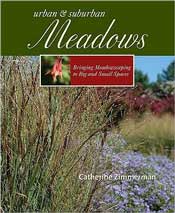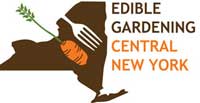Support this great environmental film project
|
 | |
Catherine Zimmerman's book on meadows
|
|
Kickstarter is a new way to fund and follow creativity. This organization provides a way to get interesting projects funded not by venture capitalists, but by everyday people -- like us habitat gardeners! One project in particular is of interest to Wild Ones. Catherine Zimmerman, the author of a book on creating meadows and experienced videographer, wants to create a video on the topic. (Read her blog post praising Wild Ones!) Kickstarter works by having people pledge a certain amount to help fund the project, BUT if the total amount needed isn't reached by a certain date, the project is dropped and the pledge is not activated. The Meadow Project needs $20,000, of which more than $8,000 is now pledged by over 100 backers. The remaining amount must be pledged by Feb. 20 or the project won't happen.Watch this video, supporting The Meadow Project, to hear Doug Tallamy, author of Bringing Nature Home, talk about Why Native Plants. The Meadow Project page also has additional links supporting the project. Please consider supporting this effort!
|
Designing with Native Plants Symposium
Fri-Sat, Feb 10-11
|  | The 2012 conference will explore the theme of Regional Identity for Upstate New York.
Our regional identity is reflected in, and shaped by, plans, designs and projects using native plants and ecologically based principles.
Registrants will include landscape architects, designers, educators, Master Gardeners, government employees, homeowners and anyone else eager to learn more about this growing movement. Speakers will include professional landscape architects, ecologists, horticulturists, contractors, educators, and conservationists. The two day format will include full length presentations and panel discussions. For more information and to register ... |
| Annual Soil & Water Conservation District Plant Sale |
 | |
Red oak in late fall
|
|
This can be an opportunity to get inexpensive plants, many of which are native, BUT not all (for example, rose of sharon, which we would not recommend). Do some research before ordering-- but you should always do this before selecting plants! Here are some of the natives offered: Balsam fir, hemlock, red pine, white pine, American cranberry viburnum, American filbert, black cherry, paper birch, red maple, red oak, white oak, strawberry bush, sugar maple. There are also conservation packs of ferns and a songbird mix of trees/shrubs. (We do not recommend the "butterfly conservation pack.") Plant descriptionsOrder Form |
| Our Habitat Garden |  |
Visit Our Habitat Garden website for information on providing habitat, earth-friendly gardening practices, plants, and various creatures here in Central New York. |
| HGCNY on Facebook |
As as more of us participate on our Facebook page, this will become a useful resource for asking (and answering!) local HGCNYers' questions about habitat gardening. Join in what can become a very useful conversation about habitat gardening in Central New York.
|
|
Join HGCNY!
|  |
Becoming an official member of HGCNY is easy: just join Wild Ones! When you're a Wild Ones member, you're automatically an official member of HGCNY. |
| Interested in Edible Gardening? | 
|
If you'd like to get information on Edible Gardening CNY, just email John to find out about edible gardening tours and programs.
|
|
Greetings!
We're excited that our first program of 2012 presents a new alternative to the typical American lawn.
As Michael Pollan said in his 1991 New York Times Op Ed Classic,
 "The lawn is a symbol of everything that's wrong with our relationship to the land. Lawns require pampering because we ask them to thrive where they do not belong. Turfgrasses are not native to America, yet we have insisted on spreading them from the Chesapeake watershed to the deserts of California without the slightest regard for local geography. Imposed upon the land with the help of our technology, lawns encourage us in the dangerous belief that we can always bend nature to our will. They may bespeak democratic sentiments toward our neighbors, but with respect to nature the politics of lawns are totalitarian." "The lawn is a symbol of everything that's wrong with our relationship to the land. Lawns require pampering because we ask them to thrive where they do not belong. Turfgrasses are not native to America, yet we have insisted on spreading them from the Chesapeake watershed to the deserts of California without the slightest regard for local geography. Imposed upon the land with the help of our technology, lawns encourage us in the dangerous belief that we can always bend nature to our will. They may bespeak democratic sentiments toward our neighbors, but with respect to nature the politics of lawns are totalitarian."
What to do? One solution is to substitute native plants for the non-natives that comprise conventional lawns.
Krissy Faust of Cornell Plantations has been developing a native plant mix that can function as a No Mow lawn. Come hear all about it at our January meeting.
~ Here's a video interview with Krissy Faust.
WHEN: Sunday, January 29 at 2:00 PM
WHERE: Liverpool Public Library (Directions)
Free and open to the public.
Come and bring a friend!
 Cancellations? Cancellations?
In HGCNY's ten-year history, we've cancelled very few programs, but here in CNY, storms are always a possibility.
If the weather is bad, call Liverpool Library at 457-0310 to see if it's closed. Also, look for an email or check Facebook or our website for cancellation information.
 | Coral honeysuckle
(Lonicera sempervirens) |
Native Plants Symposium
Note that the annual Native Plants Symposium in Ithaca is in February this year. Here's a .pdf file describing the event. For more information see the sidebar in this newsletter and also on the Symposium website.
~ Janet Allen
|
|
|
Test your knowledge
QUESTION: Name a butterfly that overwinters HERE IN CNY as an adult--in other words, as a butterfly, not as an egg, caterpillar, or chrysalis.
(The answer is at the end of the newsletter.)
|
Save the date (Friday through Monday, February 17-20) to participate in the 15th annual Great Backyard Bird Count, sponsored by Cornell Lab of Ornithology and Audubon. This four-day event engages bird watchers of all ages in counting birds to create a real-time snapshot of where the birds are across the continent. Anyone can participate, from beginning bird watchers to experts. It takes as little as 15 minutes on one day, or you can count for as long as you like each day of the event. It's free, fun, and easy--and it helps the birds. Find out more about the GBBC. An instructional video is available. Here's a special page for kids! Highlights from the 2011 GBBC results. Binocular Basics from Audubon and Cornell Lab of Ornithology.
|
 | |
Honeybee on an aster
|
Honeybees: an update Though not as frequently in the news as in past years, honeybees are still in trouble -- as will be many of our food crops they pollinate. Reaching a critical pointAccording to an article in Grist the honeybee problem is reaching a critical point. From the article: "In addition to continued reports of CCD (colony collapse disorder) -- a still somewhat mysterious phenomenon in which entire bee colonies literally disappear, alien-abduction style, leaving not even their dead bodies behind -- bee populations are suffering poor health in general, and experiencing shorter life spans and diminished vitality. And while parasites, pathogens, and habitat loss can deal blows to bee health, research increasingly points to pesticides as the primary culprit." Read more ...Other research reported by the Environmental News Network indicates that a parasitic fly may also be attacking honeybees.
From the article: "A new study from the San Francisco State University suggests that one factor may be a parasitic fly, Apocephalus borealis, which lays its eggs in the bees' abdomens. The parasitic eggs cause atypical behavior in the bees, causing them to abandon their hives. Like a scene out of Alien, the eggs eventually hatch and the newborn flies burst out of the bee, killing it in the process." Read more ... What we can doPesticides, parasites, loss of habitat, and poor nutrition are some of the possible causes of the honeybee's decline. Whatever the reason, there is much we can do in our own yards to help bees and pollinators in general, not just the non-native honeybee. See Our Habitat Garden for some suggestions. There's an app for that!The Pollinator Partnership has a BeeSmart app that's a comprehensive guide to selecting plants for pollinators specific to your area. |
|
Name a butterfly that overwinters as an adult? Here's the answer
 | | Mourning cloak |
Actually, there are three fairly common butterflies that overwinter as adults:
* mourning cloak
* question mark
* comma
What does that mean for us?
In late winter or early spring Be on the lookout. These may be some of the earliest butterflies you see--a very welcome sight at this time of year!
In summer Provide nectar especially larval host plants.
Host plants:
* Mourning cloak: Willow, aspen, cottonwood, elm
* Question mark: Elm, hackberry, nettles
* Comma: Elm, hops, nettles
Nectar:* Mourning cloak: prefers tree sap, especially from oaks; also rotting fruit; sometimes flower nectar * Question mark: prefers rotting fruit, tree sap, dung, carrion, but it will also visit flowers such as milkweed in a pinch
* Comma: rotting fruit and tree sap
In FALL! Make sure they have a place to overwinter! They're often victims of our efforts to "neaten up" our yards in the fall. Only in our own lifetime has it become fashionable to remove all the products of the growing season, impoverishing many creatures and the soil itself.
Native Plants & Wildlife Gardens has a blog post that describes how to create a functioning "butterfly house" (not the useless commercial kind).
Read more about mourning cloaks, question marks, and commas from the Butterflies and Moths of North America website.
Read more about how other butterflies overwinter in Our Habitat Garden. |
|
|
|
|